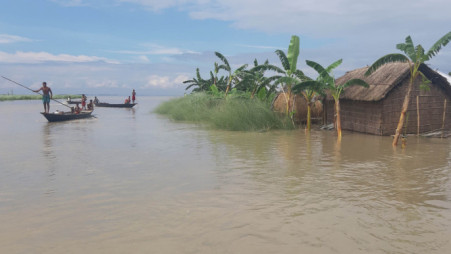More catastrophic Brahmaputra flooding feared
The tree-ring study shows that there have been much wetter periods in the past, especially since 1300

Asia's mighty Brahmaputra River, which flows through Bangladesh, usually gives rise to major flooding every four and a half years. A new study conducted on the tree rings in the Brahmaputra basin indicates that this flooding cycle might come down to three years as the climate warms up.
The study, published in the journal Nature Communications, found that flood hazards due to the high discharge in the Brahmaputra is severely underestimated at 24-38% if the discharge-gauge or instrumental record since 1956 is considered.
Researchers of the study put emphasis on the greater availability of real-time river discharge data across the Brahmaputra basin states – China, India, Bhutan and Bangladesh – and suggest that it will help in developing better preparedness in times of increased flood hazards.
While most climate models predict an intensified monsoon and increase in flood risk with global warming, the researchers have detected shortcomings in the instrumental data because the instrumental period, particularly 1956-1986, was amongst the driest of the past seven centuries.
The tree-ring study shows that there have been much wetter periods in the past, especially since 1300.
How tree rings can gauge changes in river flow
Tree rings provide information on a tree's history. They hold a wealth of information about not only a tree's past but also that of the ecosystem in which it lives. Environmental conditions of the past can be remodelled by studying the tree rings of the species of trees growing in a particular region.
As trees grow, they incorporate information about the environmental conditions they are living in through their annual growth rings. Trees in the region grow more and put on wide rings in wet monsoon years. Conversely, in dry monsoon years or droughts, trees grow less and put on narrow rings.
Tree ring research can lead the way for a formulation of better water management policies in the present and, what could possibly be, a water-scarce future. Based on annual data, scientists have reconstructed a monthly database of the stream flow of rivers.
Explaining the latest tree-ring study on the Brahmaputra in a mail to The Business Standard, lead author Mukund Palat Rao – a PhD graduate of Columbia University's Lamont-Doherty Earth Observatory – said the "reconstruction" of past discharge using tree-rings is known as Dendrochronology.

"Since some of these trees can live for a long time, by taking a small pencil thin tree-core from these trees and measuring their rings under a microscope we can learn more about climate conditions for the past several centuries," Rao said.
Samples were from the rings of ancient trees at 28 sites in Tibet, Myanmar, Nepal and Bhutan, at sites within the Brahmaputra watershed.
The researchers calculated projections of runoff for the Brahmaputra at Bahadurabad, shortly after the river enters Bangladesh from Assam, India, and got continuous simulations from 1850 through 2099.
Their future projections suggest a large increase in the Brahmaputra's discharge, which is expected to persist and intensify through the 2050-2099 period.
Rao wrote, "We calculated future projections of river discharge based on our best estimate of future emissions of carbon-dioxide by us."
What local experts say about the study
The Brahmaputra contributes nearly half of the 40,000 cubic metres per second mean annual discharge of the Ganga-Brahmaputra-Meghna river system.
The river and its tributaries provide important societal, ecological, cultural and economic services to more than 60 million people in Bangladesh, North-eastern India, Bhutan, and Tibet, China.
Flooding in the river causes human suffering between July and September every year.
Arifuzzaman Bhuyan, executive engineer at the Flood Forecasting and Warning Centre, Bangladesh, told The Business Standard that water discharge in the Brahmaputra has been increasing in the recent years.
"Frequency of high annual discharge in the Brahmaputra has increased in the last five years. But recent records are still too inadequate to call for a comment. We need further research," said Arifuzzaman.
Dr Asif M Zaman, managing director of Esolve International Ltd, a professional infrastructure and environmental services company, finds the recent study interesting as it has been done on the basis of dendrochronology.
"The study may be interpreted in another way as climate change is not the only cause of frequent flooding. However, this is a reminder to policy makers because risks of hazardous flooding are inevitable," Asif said.
In monsoon, high discharge in the Brahmaputra inundates parts of Bangladesh first and then comes the high discharge of the River Padma. Interestingly, during the two floods in 1988 and 1998, some of the worst in the country's history, the Brahmaputra overflowed later than the Padma.
"If the two river systems overflow simultaneously in the time of the full moon, the spring tides will submerge the flood plains devastatingly," Asif informed.
Explaining, Columbia University scholar Rao said flood risk has three parts: hazard, vulnerability and exposure.
"In our study we only talk about flood hazards. In terms of policy making, we can still reduce flood risk by reducing our vulnerability and exposure. So, we need to continue to assess mitigation structures, e.g. embankments, polders, etc, to make sure that people can withstand flooding both right now and into the future," he said.
To him, Bangladesh has already been doing a great job in developing its early warning capabilities. "Continuing to advance the facilities, that would be great!" he concluded.



 Keep updated, follow The Business Standard's Google news channel
Keep updated, follow The Business Standard's Google news channel

















